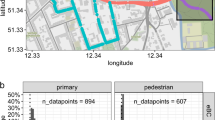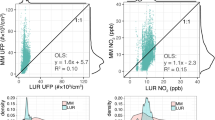Abstract
Residential wood burning can be a significant wintertime source of ambient fine particles in urban and suburban areas. We developed a statistical model to predict minute (min) levels of particles with median diameter of <1 μm (PM1) from mobile monitoring on evenings of winter weekends at different residential locations in Quebec, Canada, considering wood burning emissions. The 6 s PM1 levels were concurrently measured on 10 preselected routes travelled 3 to 24 times during the winters of 2008–2009 and 2009–2010 by vehicles equipped with a GRIMM or a dataRAM sampler and a Global Positioning System device. Route-specific and global land-use regression (LUR) models were developed using the following spatial and temporal covariates to predict 1-min-averaged PM1 levels: chimney density from property assessment data at sampling locations, PM2.5 “regional background” levels of particles with median diameter of <2.5 μm (PM2.5) and temperature and wind speed at hour of sampling, elevation at sampling locations and day of the week. In the various routes travelled, between 49% and 94% of the variability in PM1 levels was explained by the selected covariates. The effect of chimney density was not negligible in “cottage areas.” The R2 for the global model including all routes was 0.40. This LUR is the first to predict PM1 levels in both space and time with consideration of the effects of wood burning emissions. We show that the influence of chimney density, a proxy for wood burning emissions, varies by regions and that a global model cannot be used to predict PM in regions that were not measured. Future work should consider using both survey data on wood burning intensity and information from numerical air quality forecast models, in LUR models, to improve the generalisation of the prediction of fine particulate levels.
This is a preview of subscription content, access via your institution
Access options
Subscribe to this journal
Receive 6 print issues and online access
$259.00 per year
only $43.17 per issue
Buy this article
- Purchase on Springer Link
- Instant access to full article PDF
Prices may be subject to local taxes which are calculated during checkout

Similar content being viewed by others
Abbreviations
- DEM:
-
digital elevation model
- GEM-MACH:
-
Global Environmental MultiScale-Modelling Air quality and CHemistry
- LUR:
-
land use regression
- NAPS:
-
National Air Pollution Surveillance
- PM1:
-
particle with median diameter of <1 μm
- PM2.5:
-
particle with median diameter of <2.5 μm
- RMSE:
-
root mean square error
- TEOM-FDMS:
-
tapered element oscillating microbalance-filter dynamics measurement system
References
Carter A.M., Germain A., Rousseau J., Bisson M., and Gagnon C. Campagne d’échantillonnage sur le chauffage résidentiel au bois: Rapport d’étude 1999 à 2002. Rapport conjoint Environnement Canada, Ministère de l’environnement du Québec et Ville de Montréal, 2004, 88p.
Larson T., Su J., Baribeau A.M., Buzzelli M., Setton E., and Brauer M. A spatial model of urban winter woodsmoke concentrations in Vancouver, B.C. Environ Sci Technol 2007: 41: 2429–2436.
Polissar A.V., Hopke P.K., and Poirot R.L. Atmospheric aerosol over Vermont: chemical composition and sources. Environ Sci Technol 2001: 35 (23): 4604–4621.
Allen R., Larson T., Sheppard L., Wallace L., and Liu L.J. Use of real-time light scattering data to estimate the contribution of infiltrated and indoor-generated particles to indoor air. Environ Sci Technol 2003: 37 (16): 3484–3492.
Hays M.D., Geron C.D., Linna K.J., Smith N.D., and Schauer J.J. Speciation of gas-phase and fine particle emissions from burning of foliar fuels. Environ Sci Technol 2002: 36 (11): 2281–2295.
Kleeman M.J., Schauer J.J., and Cass G.R. Size and composition distribution of fine particulate matter emitted from wood burning, meat charbroiling, and cigarettes. Environ Sci Technol 1999: 33 (20): 3516–3523.
Naeher L.P., Brauer M., Lipsett M., Zelikoff J.T., Simpson C.D., Koenig J.Q., and Smith K.R. Woodsmoke health effects: a review. Inhal Toxicol 2007: 19 (1): 67–106.
Tian D., Hu Y., Wang Y., Boylan J.W., Zheng M., and Russell A.G. Assessment of biomass burning emissions and their impacts on urban and regional PM2.5: a Georgia case study. Environ Sci Technol 2009: 43 (2): 299–305.
Setton E.M., Hystad P.W., and Keller C.P. Opportunities for using spatial property assessment data in air pollution exposure assessments. Int J Health Geogr 2005: 4: 26.
Ward T.J., Lynn R.R., and Lange T. The 2003/2004 Libby, Montana PM2.5 Source Apportionment Research Study. Aerosol Sci Technol 2006: 40 (6): 166–177.
Wu C.F., Larson T.V., Wu S.Y., Williamson J., Westberg H.H., and Liu L.J. Source apportionment of PM(2.5) and selected hazardous air pollutants in Seattle. Sci Total Environ 2007: 386 (1–3): 42–52.
Fine P.M., Cass G.R., and Simoneit B.R.T. Chemical characterization of fine particle emissions from the fireplace combustion of wood types grown in the Midwestern and Western United States. Environ Eng Sci 2004a: 21 (3): 387–409.
Fine P.M., Cass G.R., and Simoneit B.R.T. Chemical characterization of fine particle emissions from the wood stove combustion of prevalent United States tree species. Environ Eng Sci 2004b: 21 (6): 705–721.
Schmidl C., Marr L.L., Caseiro A., Kotianova P., Berner A., Bauer H., Kasper-Giebl A., and Puxbaum H. Chemical characterisation of fine particle emissions from wood stove combustion of common woods growing in mid-European Alpine regions. Atmos Environ 2008: 42: 126–141.
Su J.G., Larson T., Baribeau A.M., Brauer M., Rensing M., and Buzzelli M. Spatial modeling for air pollution monitoring network design: example of residential woodsmoke. J Air Waste Manag Assoc 2007: 57 (8): 893–900.
Acknowledgements
This project was funded by a memorandum of agreement with Health Canada and by the Quebec Fonds Vert. We thank Alexandre Joly and Sabrina Cardin-Ouellette for assistance with mobile monitoring. We also thank the Quebec Ministry of Sustainable Development and Parks and Environment Canada for access to their air pollutant and meteorological surveillance data.
Author information
Authors and Affiliations
Corresponding author
Ethics declarations
Competing interests
The authors declare no conflict of interest.
Additional information
Supplementary Information accompanies the paper on the Journal of Exposure Science and Environmental Epidemiology website
Supplementary information
Rights and permissions
About this article
Cite this article
Smargiassi, A., Brand, A., Fournier, M. et al. A spatiotemporal land-use regression model of winter fine particulate levels in residential neighbourhoods. J Expo Sci Environ Epidemiol 22, 331–338 (2012). https://doi.org/10.1038/jes.2012.26
Received:
Accepted:
Published:
Issue Date:
DOI: https://doi.org/10.1038/jes.2012.26
Keywords
This article is cited by
-
Air pollution, epigenetics, and asthma
Allergy, Asthma & Clinical Immunology (2016)
-
Applying land use regression model to estimate spatial variation of PM2.5 in Beijing, China
Environmental Science and Pollution Research (2015)



